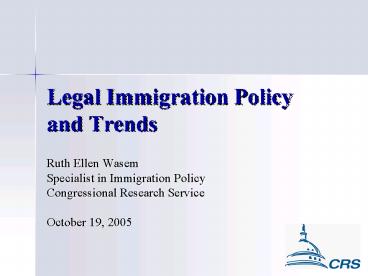Legal Immigration Policy and Trends - PowerPoint PPT Presentation
1 / 23
Title:
Legal Immigration Policy and Trends
Description:
Public charge (e.g., indigence) Health-related. Seeking to work without proper labor certification ... Illegal entrants and immigration law violations ... – PowerPoint PPT presentation
Number of Views:31
Avg rating:3.0/5.0
Title: Legal Immigration Policy and Trends
1
Legal Immigration Policy and Trends
- Ruth Ellen Wasem
- Specialist in Immigration Policy
- Congressional Research Service
- October 19, 2005
2
Outline of Presentation
- Overview of U.S. Immigration Policy
- Permanent Admissions
- Principles
- Numerical Limits
- Categories
- Admissions Trends
- Temporary Admissions
- Visa Categories
- Admissions
- Employment-based Trends
- Concluding Remarks
3
General Groupings of Foreign Born Residents
- Noncitizens
- Legal permanent resident aliens
- Nonimmigrant (temporary) alien residents
- Unauthorized aliens
- Naturalized citizens
4
Principles of Legal Permanent Immigration
- Family Reunification
- Needed Economic Skills
- Humanitarian Concerns
- Country of Origin Diversity
5
Grounds for Exclusion
- Criminal history
- National security
- Public charge (e.g., indigence)
- Health-related
- Seeking to work without proper labor
certification - Illegal entrants and immigration law violations
- Ineligible for citizenship
- Previously removed (i.e., deported)
6
Numerical Limits on Legal Immigration
7
Figure 1. Trends in Permanent Status Adjustments
and Arrivals
8
Figure 2. Legal Permanent Residents by Category,
FY2004
9
Permanent Family-Based Immigration
- Immediate relatives -- spouses and unmarried
minor children of U.S. citizens and the parents
of adult U.S. citizens - 1st preference -- unmarried sons and daughters of
citizens - 2nd preference -- spouses and children of LPRs
unmarried sons and daughters of LPRs - 3rd preference -- married sons and daughters of
citizens - 4th preference -- siblings of citizens age 21 and
over
10
Figure 3. Trends in Permanent Family-Based
Immigration
11
Permanent Employment-Based Immigration
- 1st preference -- persons of extraordinary
ability in the arts, science, education,
business, or athletics outstanding professors
and researchers and multinational executives and
managers - 2nd preference -- members of the professions
holding advanced degrees or persons of
exceptional abilities in the sciences, art, or
business - 3rd preference -- skilled shortage workers with
at least 2 years training or experience,
professionals with baccalaureate degrees and up
to 10,000 unskilled shortage workers - Also provides for special immigrants investors
12
Figure 4. Trends in Permanent Employment-Based
Immigration
13
Figure 5. Trends in New Arrivals and Adjustments
of Status
14
Nonimmigrant (Temporary) Admissions
- Aliens who are admitted to the U.S. for a
temporary period and an expressed purpose - 24 major nonimmigrant visa categories and 72
specific types of nonimmigrant visas - Commonly referred to by their subsection in INA,
e.g., B-2 tourists, E-2 treaty investors, or F-1
foreign students - Most are required to prove that they are not
coming to live permanently(214(b) INA)
15
Figure 6. Nonimmigrants by Visa Category, FY2004
16
Employment-Based Temporary Visas
- Cultural Exchange
- Multinational Executives and International
Investors - Temporary Workers
- Crewmen
- Outstanding Artists, Athletes, Performers
17
Figure 7. Trends in Temporary Employment-Based
Immigration
18
H-1B Professional Specialty Workers
- Dual intent (may have LPR petition pending)
- Labor attestation
- Current limit of 65,000 annually
- Renewable for up to 6 years
19
H-2A Agricultural Workers
- Seasonal or temporary agricultural work
- Labor certification
- Adverse Effect Wage Rate (AEWR)
- Housing and other benefits
- Maximum stay of 3 years
- No numerical limits
20
H-2B Non-agricultural Workers
- Labor certification
- Temporary need for workers
- Prevailing wage rate
- Maximum stay of 3 years
- Limit of 66,000 annually
21
Avenues for Adjusting to Permanent Resident Status
22
Towards a More Effective Immigration Policy
23
Concluding Remarks
- Immigration policy develops in broader contexts
- Anti-terrorism
- Labor force needs
- Family values
- Immigration policy weighs balance of concerns
- National security
- Economic considerations
- Humanitarian concerns
- Immigration policy faces competing priorities































